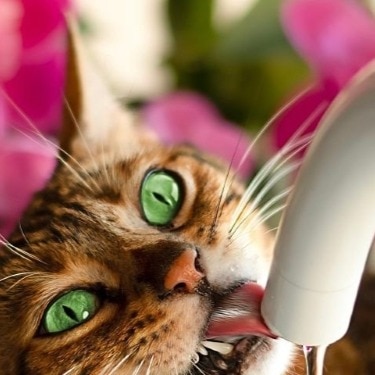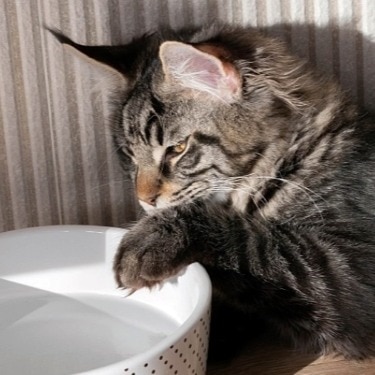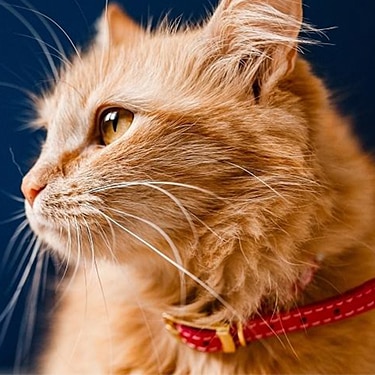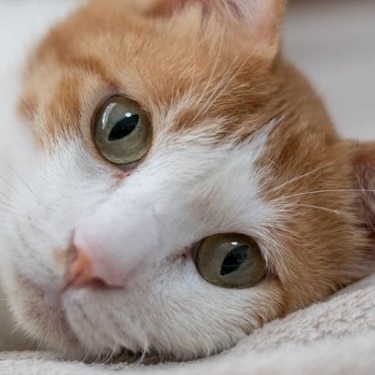The head of the Bobtail is an equilateral triangle with the tall ears standing upright on the top of the head and tilted slightly forward. The cheek bones are prominent. The eyes are rounded when viewed from the front but slanted when viewed from the side. The nose has a gentle dip. The hind legs on the bobtail are longer than the front legs, but she stands in a level stance. The naturally occurring short, kinked tail is as individual as a fingerprint, and no two are the same. This tail is full and complete with all the vertebrae found in the tail of the long tailed cats. In essence, the tail is shorter than that of other breeds but can still be seen. The kinking of the tail causes the fur on the tail to spread or stand out creating a look similar to that of a bunny tail. In the long hair Japanese Bobtail, the extra length of the fur on the tail may cause the tail to plume.
The coat on a Japanese Bobtail is soft and silky with little undercoat. The Shorthair Bobtail has a short coat, and the Longhair Bobtail has fur that is longer than that of the shorthair, but really only medium in length. The length of hair on the long hair tends to be more apparent on the back of the legs where the fur forms britches around the neck and on the belly and tail.
The Japanese Bobtail is an active, sweet, loving and highly intelligent breed. They love to be with people and play seemingly endlessly. They learn their name and respond to it. They bring toys to people and play fetch with a favorite toy for hours. Bobtails are social and are at their best when in the company of people. They take over the house and are not intimidated. If a dog is in the house, Bobtails assume Bobtails are in charge. While they get along fairly well with other cat breeds, they prefer the company of other Bobtails. They have been called clannish as they make long lasting friendships with their own litter mates.
The Japanese Bobtails never got over being adored by the Imperial family of Japan, and they deem anything in the house to be automatically theirs. They have a soft, sweet, melodious voice and tend to use this sing-song voice in order to persuade people to give them their every desire.
Living with a Japanese Bobtail is easy. They adapt well to a routine as long as they have some play time and some time to cuddle with their parent. While they are not lap cats, they want to be close to you and will sit next to you and sleep next to you in the bed. Because they can jump high, they need some perches so they can exercise. They like interactive toys such as feather teasers and will jump high to catch it.
Japanese Bobtails generally exercise enough to maintain their proper weight. They do love treats, however, whether they are cat treats or a taste of people food, and it is easy to indulge them to the point where they have gained weight.
The Japanese Bobtail has been known in Japan since the 6th century. The Gotokuji Temple and the Niko Temple still display antique Japanese woodcuts and paintings that portray the Japanese people's love for their special bobtailed cat. The Japanese Bobtail is considered to be a naturally occurring breed and was not affirmatively created.
The Japanese Bobtail was originally kept by people who had silkworm barns as the breed was considered invaluable thanks to their expertise in rodent control. However, the Imperial family so loved the Japanese Bobtail that the cats were granted all the privileges of the ruling classes, and were pampered and honored just like royalty. Legend has it that one of the great emperors found the Japanese Bobtail to be such a lovely cat that he decreed that only he could own and breed these cats. When he gave an audience in the Imperial Garden, he would bring in his Japanese Bobtails with red silk leashes.
The Bobtail is considered a lucky cat and to have one assures prosperity and happiness. The tricolored Japanese Bobtail, or Mi-Ke (pronounced "mee kay"), is the luckiest color of this beautiful cat, probably because most tricolored cats are females and, therefore, produce more beautiful Japanese Bobtails. The Japanese statue of a cat with its paw upraised is called a Maneki Neko or beckoning cat, and is an artistic interpretation of the Bobtail. These statues are commonly found in Japanese shops where they are thought to attract good people.
Adopt a pet. Change a life.
Are you prepared to adopt a pet? Use these tools to make sure you are ready for the commitment.
Adopt a pet. Change a life.
Are you prepared to adopt a pet? Use these tools to make sure you are ready for the commitment.






















